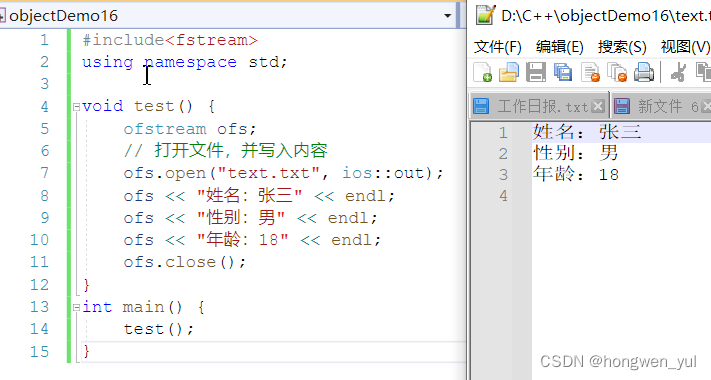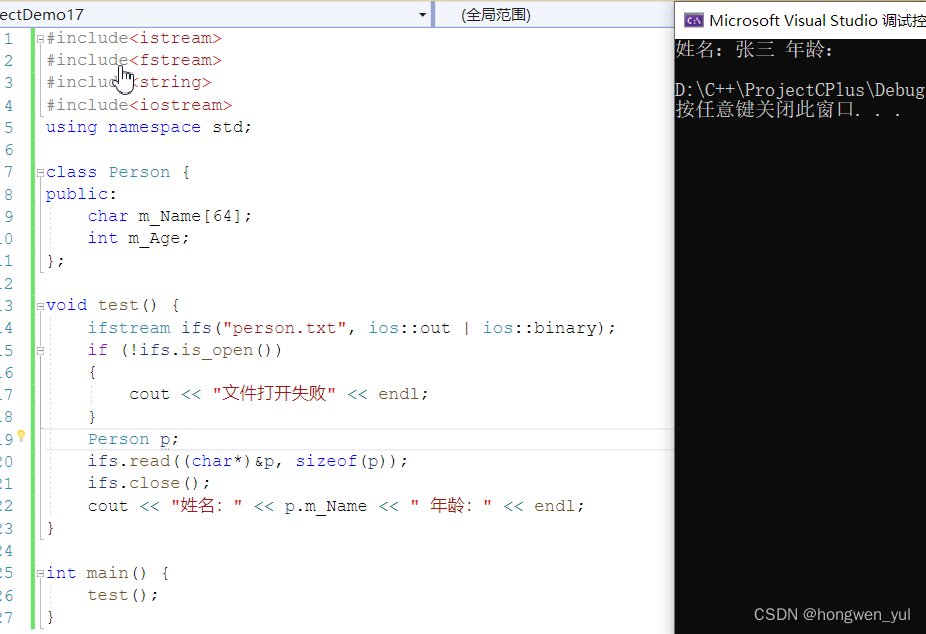前言:
程序运行时产生的数据都属于临时数据,程序一旦运行结束,数据都会被释放。通过文件可以 将数据持久化,C++ 中对文件操作需要包含头文件 <fstream>。
文件类型分为两种:
1:文本文件:文件以文本的 ASCII码形式存储在计算机中
2:二进制文件:文件以文本的二进制形式存在在计算机中,用户一般不能直接读懂他们
头文件<fstream>定义了三个类型来操作文件。
1:ofstream:写操作
2:ifstream:读操作
3:fsstream :读写操作
1:文本文件
1.1:写 文件
写文件步骤
1:包含头文件: <fstream>
2: 创建流对象 ofstream ofs
3: 打开文件 ofs.open("文件路径", 打开方式)
4:写数据 ofs<< "写入数据";
5: 关闭文件 ofs.close()
| 打开方式 | 解释 |
|---|---|
| ios::in | 为读文件而打开文件 |
| ios::out | 为写文件而打开文件 |
| ios::ate | 初始位置:文件尾 |
| ios::app | 追加方式写文件 |
| ios::trunc | 如果文件存在先删除,再创建 |
| ios::binary | 二进制方式 |
#include<fstream>
using namespace std;
void test() {
ofstream ofs;
// 打开文件,并写入内容
ofs.open("text.txt", ios::out);
ofs << "姓名:张三" << endl;
ofs << "性别:男" << endl;
ofs << "年龄:18" << endl;
ofs.close();
}
int main() {
test();
}1.2 读文件
读文件与写文件步骤相似,但是读取方式相对于比较多,读文件步骤如下
1:包含头文件:#include<fstream>
2: 创建流对象: ifstream ifs
3: 打开文件并判断文件是否打开成功 ifs.open("文件路径",打开方式)
4:读数据:四种读取方式
5:关闭流 ifs.close()
#include<fstream>
#include<istream>
#include<iostream>
#include<string>
using namespace std;
void test() {
ofstream ofs;
// 打开文件,并写入内容
ofs.open("text.txt", ios::out);
ofs << "姓名:张三" << endl;
ofs << "性别:男" << endl;
ofs << "年龄:18" << endl;
ofs.close();
}
void test2(){
// 创建文件流对象,并打开文件
ifstream ifs;
ifs.open("text.txt", ios::in);
if (!ifs.is_open())
{
cout<< "打开文件失败" << endl;
return;
}
// 方式一: 通过 while循环一行一行的读取,利用右移运算符将数据放到buf 中
//char buf[1024] = { 0 };
//while (ifs >> buf)
//{
// cout << buf << endl;
//}
//ifs.close();
// 方式二: 通过getline指定要存放数据的buf和要读取的字节
char buf2[1024] = { 0 };
cout << "要读取的字节:" << sizeof(buf2)<< endl; // 打印 1024
int count = 0;
// 从istream中读取至多n个字符(包含结束标记符)保存在s对应的数组中。即使还没读够n个字符,如果已经没有字符可读,则读取终止
while (ifs.getline(buf2,sizeof(buf2)))
{
count++;
cout << buf2 << endl;
}
cout << "读取的次数:" << count << endl; // 打印 3
ifs.close();
//第三种方式
//把所有数据放到string中,通过一个全局函数getline来读取
//全局函数getline的第一个参数为文件流对象,第二个参数为存放数据的buf
/*string buf3;
while (getline(ifs, buf3))
{
cout << buf3 << endl;
}*/
}
int main() {
test2();
return 0;
}2: 二进制文件
以二进制文件的方式对文件进行读写操作,打开文件的方式要指定为: ios::binary。
2.1 :写文件
二进制方式写文件主要利用流对象调用成员函数 write
函数原型: ostream& write(const char* buffer, int length);
参数解释:字符指针buffer 指向内存中一段存储空间,length是读写的字节数。
#include<istream>
#include<fstream>
#include<string>
using namespace std;
class Person {
public:
char m_Name[64];
int m_Age;
};
void test() {
ofstream ofs("person.txt", ios::out | ios::binary);
Person p = { "张三",18 };
ofs.write((const char*)&p, sizeof(p));
ofs.close();
}
int main() {
test();
}2.2 读文件
二进制放回读文件主要利用流对象调用成员函数 read
函数原型:istream& read(char* buffer, int length);
参数解释:字符指针buffer 指向内存中一段存储空间,length是读写的字节数
#include<istream>
#include<fstream>
#include<string>
#include<iostream>
using namespace std;
class Person {
public:
char m_Name[64];
int m_Age;
};
void test() {
ifstream ifs("person.txt", ios::out | ios::binary);
if (!ifs.is_open())
{
cout << "文件打开失败" << endl;
}
Person p;
ifs.read((char*)&p, sizeof(p));
ifs.close();
cout << "姓名:" << p.m_Name << " 年龄:" << endl;
}
int main() {
test();
}
打印结果可知:可以正常读出 person.txt 文件里面内容。

























 657
657











 被折叠的 条评论
为什么被折叠?
被折叠的 条评论
为什么被折叠?








